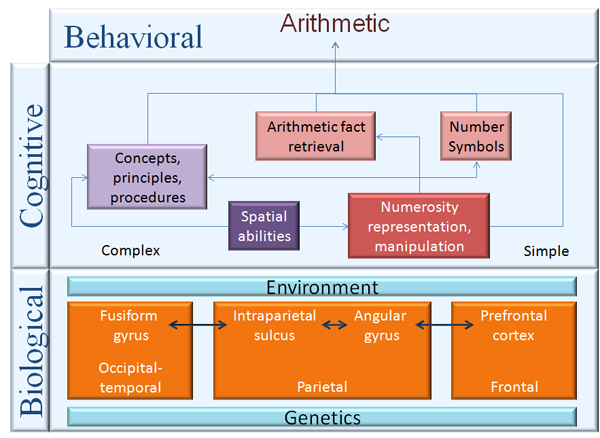
Brains Doing Math - Symbolic Analytical Language
Communication is a complex cognitive process with interactions between genetics, enviornment, neurobiology, cognition, and behavior. Symbolic analytical communication is essential in our numerate society.
Mathematics is a complex subject, involving language, spatial and magnitude relationships. The tools of math are:
Numerical expressions: number words (one, two, twenty-two, million…), numerals (1, 2, 55, 1000)
Patterns: geometric shapes, approximate and exact magnitude, roman numerals, dice, and dominoes
Mathematical facts (2 X 4 = 8)
Mathematical procedures (borrowing, long division)
Mathematical laws (a + b = b + a ).
Even basic mathematics in elementary grades requires the understanding exact magnitude or numerosity, number words, symbolic numerals and the relations between them; being able to carry out mental arithmetic using the four basic arithmetical operations – addition, subtraction, multiplication and division; being able to carry out written multi-digit arithmetic using the four basic operations; being able to solve ‘missing operand problems’; being able to solve ‘word problems’ which set mathematical problems in realistic contexts, particularly using money, time, and dates.
Childern with dyscalculia or low numerosity stumble on the first part: understanding exact numerosity, number words, symbolic numerals and the relations between them. Number sequences are memorized (4,5,6,7,8), but magitudes are not understood (8 is twice the size of 4). This core deficit in processing numerosities is analogous to the core deficit in phonological awareness in dyslexia. These children usually do not have problems with patterns or spatial relationships.
Prevelence of dyscalculia, profoundly challanged, is 5-10% and low numerosity, mild to moderately challanged, is 30% of all children. This prevelence is the same as dyslexia and reading problems. Forty percent of children with dyslexia and reading problems also have dyscalculia and low numerosity.

As with dyslexia, children with math challanges have areas of strength in right brain functions. The areas of math challanges are left brain functions in the left angular gyrus and left frontal lobe. As with dyslexia, continuous specialized left brain training has been shown to overcome the problems. This illustration depicts the high level interaction for calculating.
